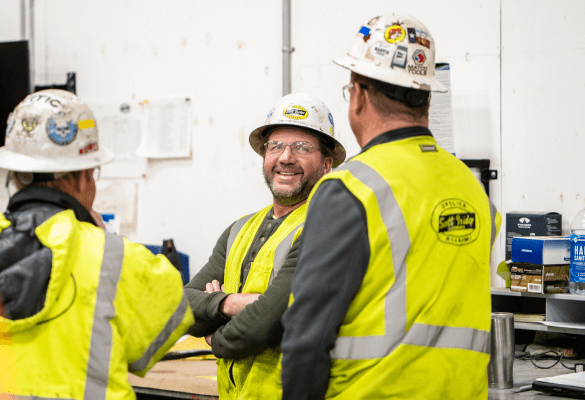How to Increase Productivity
Written by Jason Schroeder
January 16, 2022
Want to increase your crew's productivity? The answer is to go lean.
Lean beliefs top Schroeder’s list of value-added concepts in the Dirt World. And lean is about more than continual improvement or eliminating waste.
The concept of lean production comes from Toyota. “Toyota is more profitable than the next four car companies combined,” Schroeder said. “And you have to ask yourself, why? And how does this apply to the Dirt World?”
The answer to Toyota’s success is lean production. And according to Schroeder, “lean” in construction is all about learning to create flow.
“Trade flow is the single most value-added concept in lean construction,” Schroeder said. “What is trade flow? It’s your flow through a project — how well you go from area to area.”
What slows you down?
Think about the things that typically slow your projects down:
- restarts and stops
- too much work in process
- product or material defects
- roadblocks
- waste
- unevenness in the system
“These things aren’t happening when you’re doing the work,” Schroeder pointed out. “Studies show that the bottom 25% of workers — and by that I mean our least productive workers — are more productive and make more money than our average bid units. And the ones in the top 25%? They’re four times as productive.”
If even the least productive workers are still pretty darn productive, why, then, is there a productivity problem in construction?
The answer lies in the restarts and stops, the roadblocks, the missing information and materials — all things that keep you from working in the first place.
How to create flow.
According to Schroeder, creating flow is the key to lean production. But how do you create flow? “Lean construction is respect for people and resources, stable environments, total participation with visual systems, and targeting continuous improvement and fanatical quality,” Schroeder said. “And we need all four of these things happening to create flow.”
He pointed out that the typical dirt world answer of increasing production doesn’t work. When you bring on more manpower or more materials, you’re just overloading the project site. And it doesn’t make your people work any faster.
The reason for this? Responding in this way goes against the laws of lean production. And if you want to create flow, you have to understand and follow these laws.
The laws of lean production.
Little’s Law
Little’s Law states that you’ll go faster in your work if you create smaller batch sizes. For example, let’s say you’re doing a pipe installation. “Don’t do all of the grading for the entire five miles first before you bring in the next trades,” Schroeder advised. “Do the work in smaller batches. So you’re doing 800 linear feet in lockstep with all the trades flowing through.”
You also need to limit the work in process, so you can focus on getting it right the first time. “If you do something in a rush, it’ll cost you four to 12 times the original installation amount to fix it,” Schroeder noted. “And if we didn’t have the time to get it right the first time, we definitely don’t have time to get it right the second time.”
The Law of Variation
The second lean production law is the Law of Variation. According to this law, increasing variation increases the overall duration of your project.
“If you, as the foreman, are pointing here and there and changing things all day, you’re creating chaos,” Schroeder said. “You need to plan the next day, create stability, communicate your plan, and keep everyone working and achieving the day’s production targets with as little variation as possible.”
The Law of Bottlenecks
The Law of Bottlenecks states that, in any system, there will be processes that slow you down. You need to find these processes, and optimize and improve them.
“Let’s say you can dig 80 linear feet of trench in an hour,” Schroeder said. “Same for installing pipe in the trench, and backfilling, and the final grading and cleaning. You’re getting 80 linear feet in an hour. But your trench box? You’re only getting 20 feet an hour. That’s your bottleneck right there.”
Kingman’s Formula
According to the Kingman’s Formula, your estimate of the time it will take to do a task is only true if there’s no variation.
“You have to shield your crew from variation so their cycle times are optimal,” Schroeder said. “Your job is to deal with the chaos, so your people can avoid the chaos.” When you switch context — more materials, for example, or overtime — you overburden your crew and communication becomes more complex.
Brook’s Law
Finally, there’s Brook’s Law. “Brook’s law says as you increase manpower, you extend the overall duration of whatever you’re doing,” Schroeder said. “So if you want to be lean and target flow, you can’t throw resources at your project.”
Recommended reading.
To help you grasp these concepts, Schroeder also gave a list of recommended reads on lean production:
- 2 Second Lean by Paul Akers
- This is Lean by Niklas Modig
- The Bottleneck Rules by Clarke Ching
Takeaways.
Lean construction is about learning how to create flow by respecting people and resources, creating stable environments, total participation with visual systems, and targeting continuous improvement and fanatical quality.
How do you get there? You need to understand and follow the laws of lean production.
- Little’s Law: You’ll go faster in your dirt work if you create smaller batch sizes.
- The Law of Variation: Increasing variation increases the overall duration of your project.
- The Law of Bottlenecks: In any system, there will be processes that slow you down.
- Kingman’s Formula: Your estimate of the time it will take to do a task is only true if there’s no variation.
- Brook’s Law: As you increase manpower, you extend the overall duration of whatever you’re doing.














